Photoperiod-sensitivity genes shape floret development in wheat
- PMID: 30576503
- PMCID: PMC6382326
- DOI: 10.1093/jxb/ery449
Photoperiod-sensitivity genes shape floret development in wheat
Abstract
Lengthening the pre-anthesis period of stem elongation (or late-reproductive phase, LRP) through altering photoperiod sensitivity has been suggested as a potential means to increase the number of fertile florets at anthesis (NFF) in wheat. However, little is known about the effects that the Ppd-1 genes modulating plant response to photoperiod may have on reproductive development. Here, five genotypes with either sensitive (b) or insensitive (a) alleles were grown in chambers under contrasting photoperiods (12 h or 16 h) to assess their effects. The genotypes consisted of the control cultivar Paragon (three Ppd-1b) and four near-isogenic lines of Paragon with Ppd-1a alleles introgressed from: Chinese Spring (Ppd-B1a), GS-100 (Ppd-A1a), Sonora 64 (Ppd-D1a), and Triple Insensitive (three Ppd-1a). Under a 12-h photoperiod, NFF in the genotypes followed the order three Ppd-1b > Ppd-B1a > Ppd-A1a > Ppd-D1a > three Ppd-1a. Under a 16-h photoperiod the differences were milder, but three Ppd-1b still had a greater NFF than the rest. As Ppd-1a alleles shortened the LRP, spikes were lighter and the NFF decreased. The results demonstrated for the first time that Ppd-1a decreases the maximum number of florets initiated through shortening the floret initiation phase, and this partially explained the variations in NFF. The most important impact of Ppd-1a alleles, however, was related to a reduction in survival of floret primordia, which resulted in the lower NFF. These findings reinforce the idea that an increased duration of the LRP, achieved through photoperiod sensitivity, would be useful for increasing wheat yield potential.
Keywords: Ppd-1 genes; Floret development; floret initiation; floret survival; photoperiod sensitivity; wheat.
© The Author(s) 2018. Published by Oxford University Press on behalf of the Society for Experimental Biology.
Figures


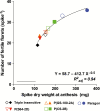
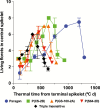
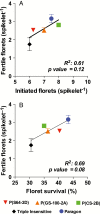
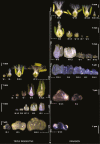

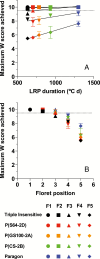
References
-
- Bentley AR, Horsnell R, Werner CP, et al. . 2013. Short, natural, and extended photoperiod response in BC2F4 lines of bread wheat with different Photoperiod-1 (Ppd-1) alleles. Journal of Experimental Botany 64, 1783–1793. - PubMed
-
- Craufurd PQ, Cartwright PM. 1989. Effect of photoperiod and chlormequat on apical development and growth in a spring wheat (Triticum aestivum) cultivar. Annals of Botany 63, 515–525.
-
- Fischer RA. 1983. Wheat. In: Anon. Symposium on potential productivity of field crops under different environments. Los Baños, Philippines: International Rice Research Institute, 129–154.
Publication types
MeSH terms
LinkOut - more resources
Full Text Sources
Research Materials
Miscellaneous

